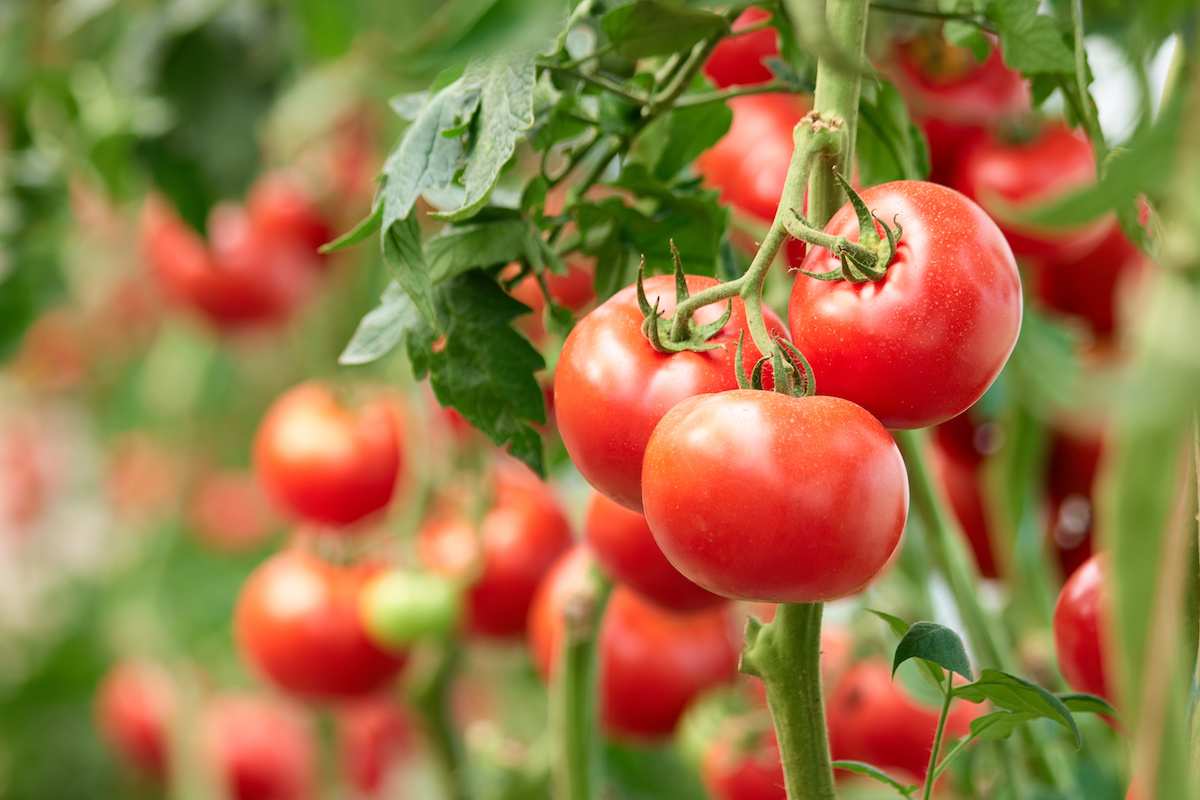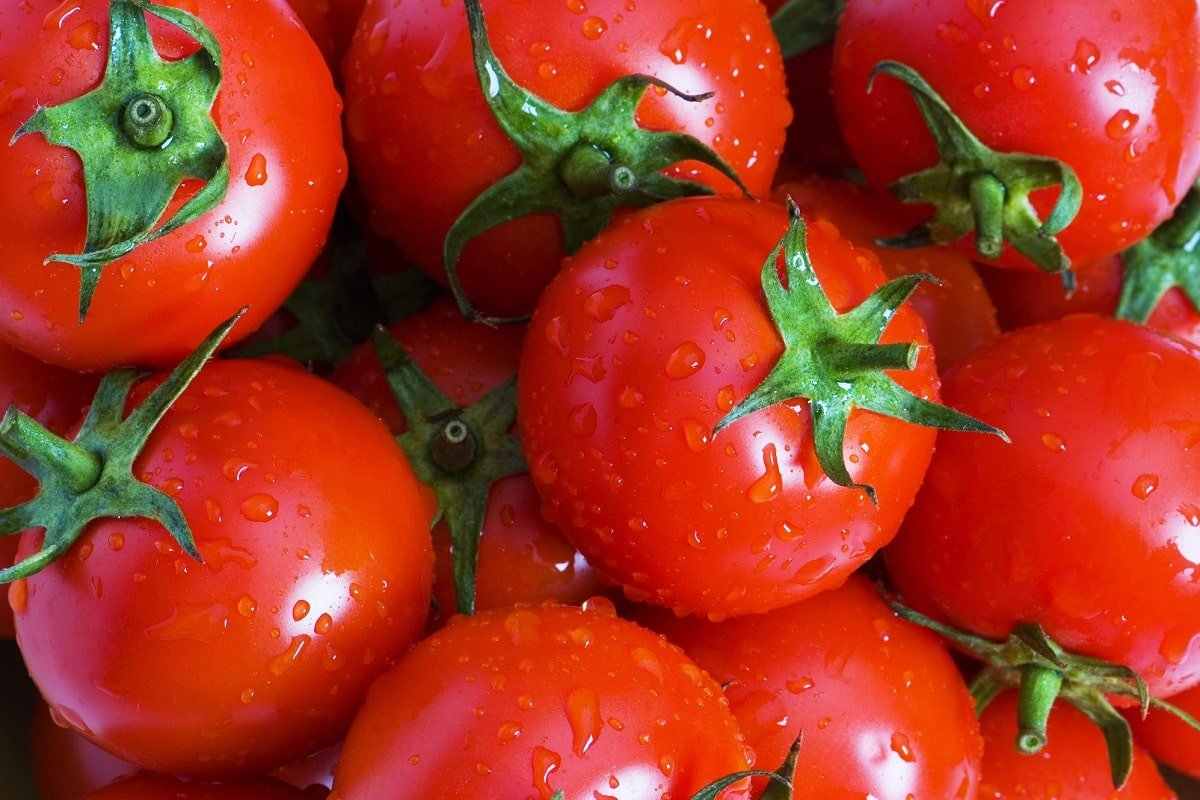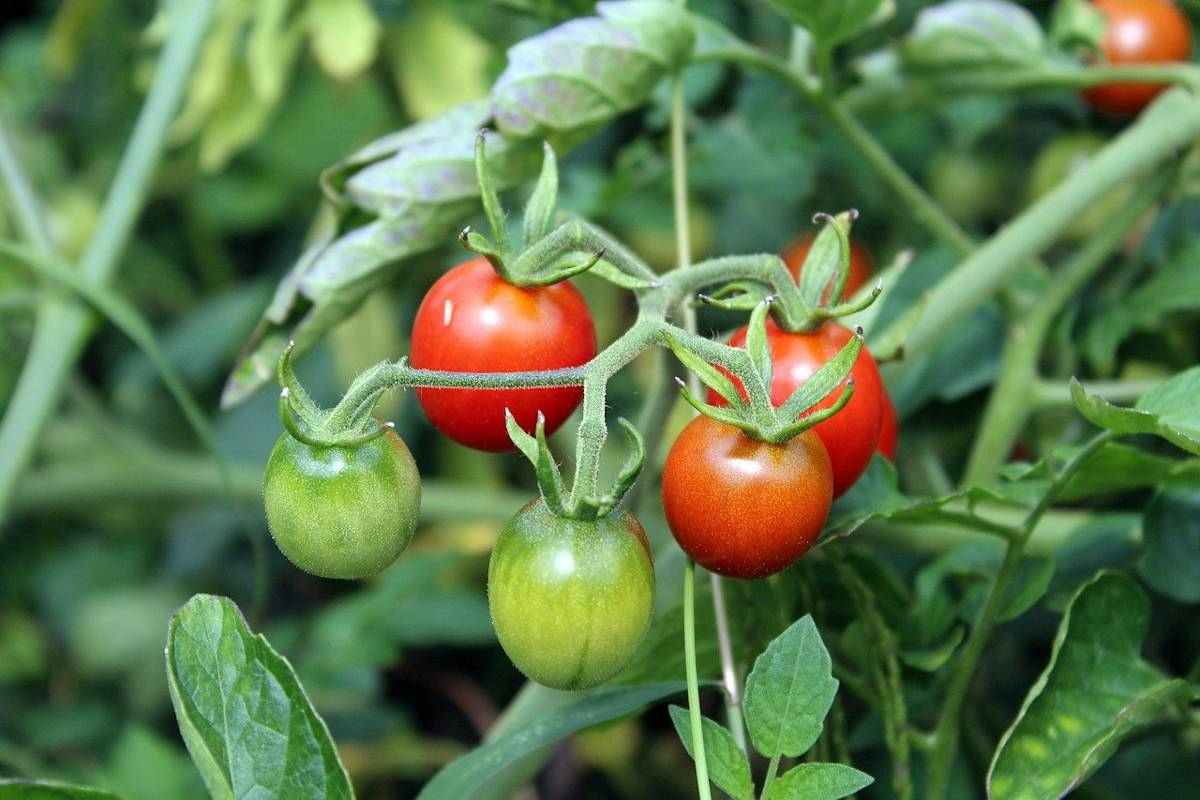It doesn’t matter whether you want to plant tomatoes in a greenhouse or under any other conditions, you need to be aware of ideal circumstances like temperature and humidity which are required for tomatoes. Good growth and excellent yields depend on photosynthesis. Reduced sugar production, as well as lower fruit quality, shelf life, and size, can result from water stress, insufficient light, or high humidity (which seals stomates and decreases gas exchange). Due to the importance of photosynthesis in plant growth, a 1% drop in available light can result in a 1% drop in harvest. The amount of light reaching the crop can be drastically reduced by shading from the surrounding topography and trees, the greenhouse structure, or taller plants inside the greenhouse.  Greenhouses, and the rows of plants within them, should face north and south to maximize the amount of light reaching all of the plants. The use of white floor coverings or paint by some cultivators is a method of redirecting light into the crop. In terms of reflectivity, clean white paint is superior to metallic or foil, and there is some evidence that foil can "confuse" insects, so reducing the damage they can do. Tomato leaves can lose their color and become thinner and paler when exposed to persistent overcast conditions. At that moment, having too much nitrogen can be harmful. When growing tomatoes, some farmers like to use shade cloth, while others don't. Shading should theoretically limit photosynthesis and total yield, although this has not always been demonstrated in controlled trials. Overall crop yields were shown to increase by as much as 30% when employing shadecloth. Direct sunlight on fruit can develop yellow or green shoulders, cracking, and russeting, therefore shading can improve fruit quality. The individual fruit trusses can be protected from the sun by leaving elder leaves on the plant. Shading can help maintain a comfortable temperature in places where summers are hot and humid. However, the location of the greenhouse, the cultivar of tomato grown, the season, and the grower's overall management method all play a role in determining whether or not shading is necessary. The greenhouse business has often used foot-candles and lumens as its primary units of measurement for illumination. The amount of light reaching a surface is measured in foot-candles, while the amount of light emitted is measured in lumens. The intensity of both natural and artificial light that reaches a plant is measured in foot-candles (f.c.), whereas the brightness of light sources like the sun and electric lamps is quantified in lumens. The barometric pressure can drop to as low as 500 f.c. in the dead of winter, and as high as 10,000 f.c. on a bright, sunny day. About 20 feet of clear space is needed for comfortable reading.
Greenhouses, and the rows of plants within them, should face north and south to maximize the amount of light reaching all of the plants. The use of white floor coverings or paint by some cultivators is a method of redirecting light into the crop. In terms of reflectivity, clean white paint is superior to metallic or foil, and there is some evidence that foil can "confuse" insects, so reducing the damage they can do. Tomato leaves can lose their color and become thinner and paler when exposed to persistent overcast conditions. At that moment, having too much nitrogen can be harmful. When growing tomatoes, some farmers like to use shade cloth, while others don't. Shading should theoretically limit photosynthesis and total yield, although this has not always been demonstrated in controlled trials. Overall crop yields were shown to increase by as much as 30% when employing shadecloth. Direct sunlight on fruit can develop yellow or green shoulders, cracking, and russeting, therefore shading can improve fruit quality. The individual fruit trusses can be protected from the sun by leaving elder leaves on the plant. Shading can help maintain a comfortable temperature in places where summers are hot and humid. However, the location of the greenhouse, the cultivar of tomato grown, the season, and the grower's overall management method all play a role in determining whether or not shading is necessary. The greenhouse business has often used foot-candles and lumens as its primary units of measurement for illumination. The amount of light reaching a surface is measured in foot-candles, while the amount of light emitted is measured in lumens. The intensity of both natural and artificial light that reaches a plant is measured in foot-candles (f.c.), whereas the brightness of light sources like the sun and electric lamps is quantified in lumens. The barometric pressure can drop to as low as 500 f.c. in the dead of winter, and as high as 10,000 f.c. on a bright, sunny day. About 20 feet of clear space is needed for comfortable reading.  The full moon's brightness is less than 1 f.c. Most greenhouse supply companies carry the General Electric Company's light meter, which features a foot-candle reading scale. Plants can benefit from supplementary artificial light such as that produced by cool white, high output fluorescent or high intensity discharge sodium vapor lamps at times when natural sunshine is absent. The ideal supplemental illumination intensity at the plant's surface is between 800 and 1000 foot-candles. Scientists studying plants now focus mostly on the light that initiates photosynthesis. The most important range of wavelengths for photosynthesis occurs between 400 and 700 nanometers. Many refer to this spectrum as the Photosynthetically Active Radiation (PAR). Between those times, brightness is equally as important as the length of day. The amount of light available to photosynthesis within the PAR range is quantified as the Photosynthetic Photon Flux (PPF) and is recorded in units of micromoles per square second. It has been established that daily totals of photosynthetically active radiation (PPF), expressed in mol/m2, correlate with total daily photosynthesis. The winter light levels in the southwest are three times higher than those in the northeastern states of New York and Ohio. This is why Arizona and other states have such a thriving greenhouse tomato industry. The only exception is when growing seedlings, but even then, supplemental lighting for vegetable crops is usually not cost-effective. Full-spectrum lighting, on the other hand, can be useful for enhancing yields in backyard or hobby settings by elongating the day to 18 hours in the winter. Plant growth, leaf size, leaf expansion rate, and ripening time are all impacted by both day and nighttime temperatures.
The full moon's brightness is less than 1 f.c. Most greenhouse supply companies carry the General Electric Company's light meter, which features a foot-candle reading scale. Plants can benefit from supplementary artificial light such as that produced by cool white, high output fluorescent or high intensity discharge sodium vapor lamps at times when natural sunshine is absent. The ideal supplemental illumination intensity at the plant's surface is between 800 and 1000 foot-candles. Scientists studying plants now focus mostly on the light that initiates photosynthesis. The most important range of wavelengths for photosynthesis occurs between 400 and 700 nanometers. Many refer to this spectrum as the Photosynthetically Active Radiation (PAR). Between those times, brightness is equally as important as the length of day. The amount of light available to photosynthesis within the PAR range is quantified as the Photosynthetic Photon Flux (PPF) and is recorded in units of micromoles per square second. It has been established that daily totals of photosynthetically active radiation (PPF), expressed in mol/m2, correlate with total daily photosynthesis. The winter light levels in the southwest are three times higher than those in the northeastern states of New York and Ohio. This is why Arizona and other states have such a thriving greenhouse tomato industry. The only exception is when growing seedlings, but even then, supplemental lighting for vegetable crops is usually not cost-effective. Full-spectrum lighting, on the other hand, can be useful for enhancing yields in backyard or hobby settings by elongating the day to 18 hours in the winter. Plant growth, leaf size, leaf expansion rate, and ripening time are all impacted by both day and nighttime temperatures.  Young plants' leaf development is slowed and their leaf size is diminished when exposed to cold nighttime temperatures. We need to keep a close eye on both the daytime and nighttime temperatures. Most plants grown in greenhouses thrive at temperatures around 5.5 degrees Celsius (10 degrees Fahrenheit) cooler at night than during the day. Temperatures between 21 and 26 degrees Celsius (70 and 79 degrees Fahrenheit) during the day and 16 and 18.5 degrees Celsius (61 and 65 degrees Fahrenheit) during the night are optimal for producing tomatoes, while many new kinds thrive with little difference between day and night (check with your seed company for recommended growing temperatures). Temperatures of 20° -22° C (68° -72° F) should be maintained at all times for seedlings before they are gradually acclimated to the diurnal temperatures. Temperatures above about 35 degrees Celsius will do serious harm to the plants, including stunting their growth and possibly even killing them. Some protein in plant cells may get denaturized when exposed to high temperatures, and this may be the physiological basis for heat damage. The fruit may abort if it is exposed to these temperatures. When temperatures are below what plants need, metabolic processes are altered, slowing growth and once again impeding fruit set. Evaporative pad cooling has competition in the form of fogging systems. In order to keep the mist nozzles from clogging, they require water that is completely free of soluble salts. Fog cooling, like fan and pad cooling, is most effective in low humidity settings. A minimum/maximum thermometer is a handy tool for taking temperature readings in greenhouses used for gardening on the side. There should be multiple thermometers spread out in the greenhouse, and they should all be checked twice a year to ensure they are accurate. Computerized, remote-monitored systems are commonplace in modern, large-scale industrial production. Temperature, humidity, irrigation, fertilization, carbon dioxide, light, and shadow are only some of the factors that can be managed by such systems.
Young plants' leaf development is slowed and their leaf size is diminished when exposed to cold nighttime temperatures. We need to keep a close eye on both the daytime and nighttime temperatures. Most plants grown in greenhouses thrive at temperatures around 5.5 degrees Celsius (10 degrees Fahrenheit) cooler at night than during the day. Temperatures between 21 and 26 degrees Celsius (70 and 79 degrees Fahrenheit) during the day and 16 and 18.5 degrees Celsius (61 and 65 degrees Fahrenheit) during the night are optimal for producing tomatoes, while many new kinds thrive with little difference between day and night (check with your seed company for recommended growing temperatures). Temperatures of 20° -22° C (68° -72° F) should be maintained at all times for seedlings before they are gradually acclimated to the diurnal temperatures. Temperatures above about 35 degrees Celsius will do serious harm to the plants, including stunting their growth and possibly even killing them. Some protein in plant cells may get denaturized when exposed to high temperatures, and this may be the physiological basis for heat damage. The fruit may abort if it is exposed to these temperatures. When temperatures are below what plants need, metabolic processes are altered, slowing growth and once again impeding fruit set. Evaporative pad cooling has competition in the form of fogging systems. In order to keep the mist nozzles from clogging, they require water that is completely free of soluble salts. Fog cooling, like fan and pad cooling, is most effective in low humidity settings. A minimum/maximum thermometer is a handy tool for taking temperature readings in greenhouses used for gardening on the side. There should be multiple thermometers spread out in the greenhouse, and they should all be checked twice a year to ensure they are accurate. Computerized, remote-monitored systems are commonplace in modern, large-scale industrial production. Temperature, humidity, irrigation, fertilization, carbon dioxide, light, and shadow are only some of the factors that can be managed by such systems.  A plant can only develop to its full potential if it has access to an abundance of water, low to moderate humidity, and adequate air movement during photosynthesis. Humidity regulates stomatal opening and closing, ion pumping, and transpiration, all of which affect calcium uptake and hormone distribution. The inability of the plant to dissipate excess heat through transpiration is exacerbated in environments with high humidity and poor air movement. When discussing humidity, most people refer to the relative humidity, which is the percentage of moisture in the air relative to how much moisture the air can contain at that temperature. Humidity, as perceived by plants, is measured in terms of vapor pressure deficit (VPD). The vapor pressure deficit (VPD) is calculated by subtracting the air's vapor pressure from the leaf's internal vapor pressure. Diffusion of water from the roots to the leaves as transpired vapor "pumps" the water up the plant due to the difference in pressure between the inside of the leaf and the exterior, which is why transpiration is a necessary part of photosynthesis. Blossom end rot (calcium shortage) and other indications of nutrient insufficiency occur when the plant is not transpiring, and thus not drawing water or nutrients into the roots, when the relative humidity is high (low VPD, greater than 90%). Water and nutrients are pushed excessively quickly through the plants, depositing nutritional ions in the leaves rather than appropriately in the fruit, which might cause the same symptoms as high VPD (low humidity, less than 50%). A sling psychrometer can be used to determine the relative humidity in a greenhouse. A humidistat or other device can provide relative humidity readings accurate to within this range. Equipment to monitor humidity is typically available from suppliers of greenhouse supplies.
A plant can only develop to its full potential if it has access to an abundance of water, low to moderate humidity, and adequate air movement during photosynthesis. Humidity regulates stomatal opening and closing, ion pumping, and transpiration, all of which affect calcium uptake and hormone distribution. The inability of the plant to dissipate excess heat through transpiration is exacerbated in environments with high humidity and poor air movement. When discussing humidity, most people refer to the relative humidity, which is the percentage of moisture in the air relative to how much moisture the air can contain at that temperature. Humidity, as perceived by plants, is measured in terms of vapor pressure deficit (VPD). The vapor pressure deficit (VPD) is calculated by subtracting the air's vapor pressure from the leaf's internal vapor pressure. Diffusion of water from the roots to the leaves as transpired vapor "pumps" the water up the plant due to the difference in pressure between the inside of the leaf and the exterior, which is why transpiration is a necessary part of photosynthesis. Blossom end rot (calcium shortage) and other indications of nutrient insufficiency occur when the plant is not transpiring, and thus not drawing water or nutrients into the roots, when the relative humidity is high (low VPD, greater than 90%). Water and nutrients are pushed excessively quickly through the plants, depositing nutritional ions in the leaves rather than appropriately in the fruit, which might cause the same symptoms as high VPD (low humidity, less than 50%). A sling psychrometer can be used to determine the relative humidity in a greenhouse. A humidistat or other device can provide relative humidity readings accurate to within this range. Equipment to monitor humidity is typically available from suppliers of greenhouse supplies.
💰 Tenfold your income 💎
